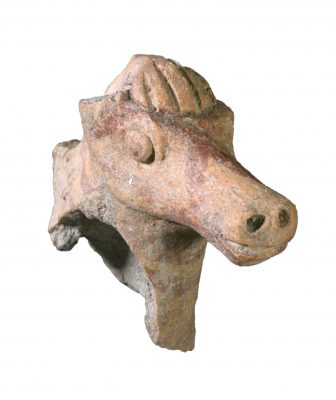×


We have detected your country as:
Please click here to go to the USA website or select another country from the dropdown list.
 Recent heavy winter rains have revealed parts of two impressive clay figurines of horses that have been buried in the ground for well over 2,000 years.
Recent heavy winter rains have revealed parts of two impressive clay figurines of horses that have been buried in the ground for well over 2,000 years.
One of the figurines was found in the vicinity of Kfar Ruppin in the Beit She’an Valley. It was dated by Israel Antiquities Authority (IAA) archaeologists to be about 2,800 years old, from the Iron Age during the Kingdom of Israel period. The second was found near Tel Akko and was identified as being 2,200 years old, from the Hellenistic period.
The figurine from Kfar Ruppin was stumbled upon by Ayelet Kidder-Goldberg, an archaeologist with the IAA. Kidder-Goldberg was out for a walk with her daughters to collect mushrooms when one of her daughters spotted the figurine poking out of the ground. Kidder-Goldberg immediately recognized that the figure was from the Iron Age.
The figurine in Tel Akko was found by a local resident, Michael Markin. Dr. Adi Erlich from Haifa University noted that the body of the horse did not survive, but most complete horses found from the Hellenistic period have riders on their backs.
According to Dr. Erlich, “The horse figurines were common in Israel during the first century BC because the use of horses had greatly increased by this time. Horses are mentioned in the Exodus story from Egypt and in the war of Barak and Dvora [Deborah] against Sisera.”
Dr. Erlich thinks the horses were sculpted for people of high social status since most people at the time could not afford to own or maintain a horse. “Figurines from the period show only men on horseback, while women were shown in the context of fertility, motherhood or sexuality. This attests to the strict gender roles prevalent in Iron Age society.”
Nir Distelfeld, an IAA inspector from the authority’s theft unit, said, “It is not unusual for heavy rains [to reveal] items of archival interest that were close to the surface. Sometimes animals such as foxes or porcupines push ancient artifacts, buried deep in the ground, up to the surface.
Source: Excerpt from an article by Edgar Asher, Ashernet
Photo Credit: Ashernet
All logos and trademarks in this site are property of their respective owner. All other materials are property of Bridges for Peace. Copyright © 2025.
Website Site Design by J-Town Internet Services Ltd. - Based in Jerusalem and Serving the World.